INTRODUCTION
Noise in the sea has been increasing with the boom of marine transportation (Kaplan and Solomon 2016), creating a new underwater soundscape worldwide, with shipping traffic being the most common anthropogenic source of noise in the ocean (Evans 2000, Würsig and Richardson 2000, Hatch and Wright et al. 2007, Weilgart 2007a, Wade et al. 2010). The contribution of shipping noise in a certain location varies depending on physiography, sound propagation, the number of ships, and the type of shipping traffic in an area (Merchant et al. 2012). Several studies have shown that many anthropogenic sounds might cause negative responses on marine organisms, manifesting as behavioral changes, habitat displacement, or even temporal or permanent physiological damage (Richardson et al. 1995, Würsig and Richardson 2000, Weilgart 2007b, Wright et al. 2007). However, the effect of noise on a taxonomic group varies depending on exposure time, frequency content, intensity, and type of sound source.
Noise sources can be classified as impulsive and continuous. Impulsive sounds are qualitatively considered to have a broadband, short duration (<1 s), and fast rise-time, such as pile driving, explosives, sonar, or air guns. On the other hand, continuous or non-impulsive sounds are those reaching a steady-state condition, regardless of duration (NMFS 2018, Martin et al. 2020). Shipping noise can be usually considered a source of the latter. There is also a difference between a particular localized ship radiating sound (focalized sound) and the overall contribution of non-localized distant ships (non-focalized sound). In the first case the received levels are highly related to the relative position of the source and the receiver, whereas in the second case the received levels are not. Marine fauna might show different negative effects depending on noise source, intensity, and duration, and on the hearing sensitivity of species. Increased shipping noise is particularly problematic for large whales, as they use sound for long-distance communication (Richardson et al. 1995); therefore, shipping noise can interfere and cause stress, mask vocalizations, and change acoustic and surface behavior (Castellote et al. 2012, Rolland et al. 2012, Tsujii et al. 2018).
Some guidelines for regulating underwater shipping noise in regard to its effects on marine species have been proposed at international committees (IMO 2009), but their enforcement depends on the country. European and American government agencies have published scientifically based regulations and guidelines to mitigate noise effects on marine mammals, including regulations on non-impulsive noise (Dekeling et al. 2014, NMFS 2018). Mexico has developed some regulations regarding passive acoustic monitoring of protected species to control underwater noise resulting from offshore seismic prospection surveys (DOF 2016); nevertheless, for vessel noise that can potentially affect marine fauna, there are no regulations to date in the country. Studies measuring underwater focalized vessel noise at important ports are necessary for understanding the relationship between anthropogenic noise contribution and biodiversity in the ocean. High-priority regions to study are the semi-enclosed bay complexes with high industrial shipping and small tourist vessel traffic. Treating vessels as focalized sources allows separating any other sources, focusing on the detected large-ship and small-vessel noise contribution.
Manzanillo port, on the coast of Colima, is near to the Mesoamerican Biological Corridor, which contains a large diversity of marine fauna (Miller et al. 2001, Holland 2012), and is part of the eastern North Pacific area with important richness of marine mammals (Ortega-Ortiz et al. 2013). Humpback whales (Megaptera novaeangliae), for example, use the region for breeding during the winter-spring months (Urbán and Aguayo 1987, Calambokidis et al. 2001). On the other hand, the Manzanillo commercial port is the busiest in Mexico, with annual cargo traffic of more than 2.1 million cargo containers or twenty-foot equivalent units. It is one of the most important ports in Latin America, connecting the Mexican central Pacific and western states internationally (SCT 2014). The bay complex in the area is a popular international tourist destination, especially the Santiago Bay side, where cruises, sport fishing, jet skiing, snorkeling, and other water sports are offered (Silva-Iñiguez et al. 2007, SECTUR 2014). However, little is known about the pervasiveness and magnitude of shipping noise in the bays. This study aims to assess ship noise contribution at 2 sites with industrial and tourism activities to establish a baseline for understanding anthropogenic influence on the soundscape of the area and its possible impact on marine fauna.
MATERIALS AND METHODS
Study area and data collection
The Santiago-Manzanillo bay complex is located in the Pacific Ocean, on the west coast of Mexico, in the state of Colima. The bay complex is composed of 2 small bodies of water separated by a small peninsula of rocky land: Santiago Bay in the northwest and Manzanillo Bay in the southeast (Fig. 1).
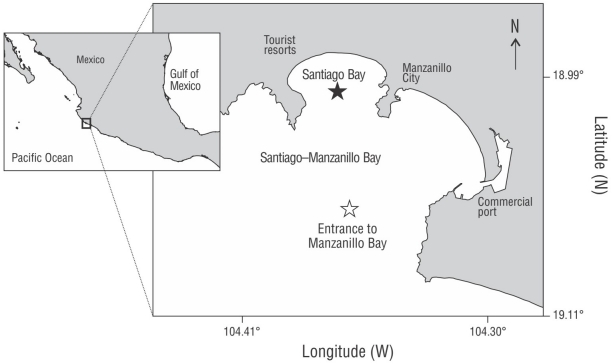
Figure 1 Location of Santiago-Manzanillo bay complex. Stars represent the recording stations, with the main commercial port docks located on the east side of Manzanillo Bay and the resorts located to the west of Santiago Bay.
Monthly acoustic samples were collected over a year, from September 2015 to August 2016. The recordings were obtained using stationary systems moored at the center of Santiago Bay (19°05ʹ51.19ʺ N, 104°22ʹ27.44ʺ W, bottom at ~35 m) and at the entrance to Manzanillo Bay (19°02ʹ21.60ʺ N, 104°22ʹ51.60ʺ W, bottom at ~105 m) to reflect the main activities in the area (Fig. 1). The systems were deployed once a month, continuously recording for 24 h each time at a sample rate of 48 kHz. Each system consisted of a hydrophone connected to a digital recorder inside a sealed plastic container. At the first station the system consisted of an SQ26-08 Cetacean Research Technology omnidirectional hydrophone (frequency response: 0.01 to 20.00 kHz; sensitivity: -200 dB re 1V/µPa) connected to a ZOOM-H1 digital recorder. At the second station the system consisted of a factory-calibrated RESON TC4013 omnidirectional hydrophone (frequency response: 0.001 to 170.000 kHz; sensitivity: -211 ± 3 dB re 1 V/µPa) that had an EC-0681 preamplifier and a band-pass filter (0 dB gain, 0.001 to 1.000 kHz) and was connected to a ZOOM-H4n recorder. The SQ26-08 hydrophone was referenced to the TC4013 hydrophone response for measurements, with a +3 dB correction factor. The recording systems were deployed at 6-7 m depth as defined by the sound speed profile (CTD SBE-19 plus, Sea-Bird electronics, Sea-Bird Data Processing v.5.3.1).
Ship catalog
After each monthly deployment, photographs of vessels near the recording sites were taken to associate them with their acoustic recordings and create a catalog. Each observation event lasted between 10 and 30 min, and information about the ships passing by was recorded in a database. A total of 16 vessels were sighted, categorized, and recorded during 15 observation events. Then, using Adobe Audition 3.0, frequency domain representations of recordings for each vessel type were visually inspected for bands that could help identify the type of vessel from the sound. Vessel categories were then defined according to these diagnostic frequency bands.
Noise from distant, out-of-sight vessels was considered negligible for accurate detection of vessels passing by the recording system. Focalized vessel noise can be regulated, but noise from distant vessels cannot. Moreover, the energy level of a nearby vessel would likely be higher, allowing for correct association of noise and vessel observation.
Data processing and analyses
Acoustic records were analyzed in the time-frequency domain in search of vessel signals. Each complete recording was visually and aurally reviewed by one analyst using the spectrograms obtained in Adobe Audition 3.0 (512 FFT Hanning window, 85% overlap, 10th-order Butterworth band-pass filter with 50-1,000 Hz). Detections were confirmed by a second analyst.
Vessels were separated into categories, and the number of detections, duration, time, and date were registered. The percentage of time with boat noise presence was calculated by month, category, and site. Duration of ship noise was estimated with the spectrogram amplitude showing energy above 75 dB noise floor, and the detection limits were taken to be the limits of the widest part of the Lloyd’s mirror effect for each vessel. The calculation is given by the following equation:
A Mann-Whitney-Wilcoxon test (Mann and Whitney 1947) was performed to compare the percentage of time with total shipping noise between Santiago Bay and the entrance to Manzanillo Bay (R GNU 3.5). Figures were created using Matlab 2013 (Mathworks), QGIS 3.2, and GIMP 2.10.14.
Root mean square (RMS) sound pressure level (SPL) values were calculated for each ship noise taking 1 min around the closest point of approach from the Lloyd’s mirror pattern. SPL is the most common sound level and is defined according to ANSI (1994) as follows:
Where
RMS sound pressure is the root mean square sound pressure defined by ANSI (1994):
where T is the period of analysis, p is the instant pressure, and t is time. Values were calculated considering the sensitivity of the hydrophone and the gain of the amplifier for each recording. RMS SPL was selected since it is the most viable measurement for reporting noise pollution during passive acoustic monitoring studies (Möser and Barros 2009). The values were calculated by month and boat category for each location.
Seasons were defined by groups of 3 months: autumn (September, October, and November), winter (December, January, and February), spring (March, April, and May), and summer (June, July, and August). Unfortunately, recordings from December at Santiago Bay and February, May, and July at the entrance to Manzanillo Bay were missing because of equipment failure.
RESULTS
Catalog of ships and recordings
The types of vessels found during visual sightings included container and gas/oil ships, bulk carriers, tuna fishing vessels, navy vessels, catamarans, and small fishing/tourist boats with outboard engines. This result supports the hypothesis that activities related to the commercial port and tourist activities are both predominant. Vessels were classified into 2 general categories according to frequency content: large ships and small vessels. The noise of the former had a predominant band of 50-220 Hz, while the latter were better distinguished in the 290-500 Hz band. However, it is important to highlight that vessel noise contribution extended to frequencies higher than the diagnostic ranges (Fig. 2).
Monthly presence of vessel noise
Throughout the year shipping noise was present in a significantly higher percentage of the time in Santiago Bay compared to the entrance to Manzanillo Bay (Mann-Whitney-Wilcoxon test: W = 17, P = 0.012), with a more noticeable difference during the summer months. However, the presence of vessel noise was relatively constant at both sites, with vessels being detected a median of 81.8% of the time in Santiago Bay and 46.6% of the time at the entrance to Manzanillo Bay. The maximum value was 90.3% for Santiago Bay in May and 83.6% for the entrance to Manzanillo Bay in April. Late spring to early autumn was the period with relatively higher percentage of shipping noise (Fig. 3).
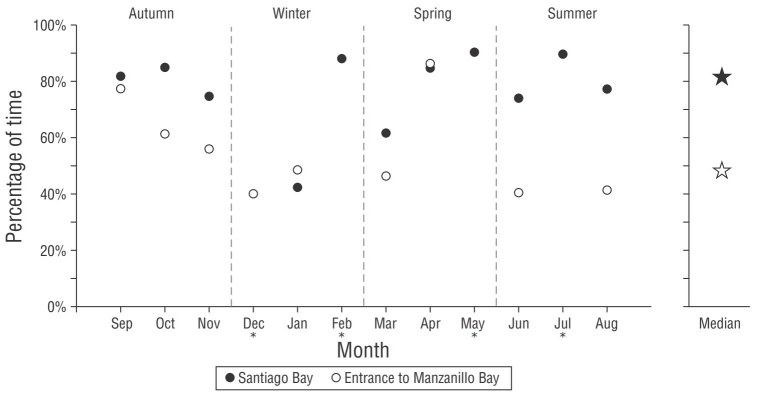
Figure 3 Percentage of time with total shipping noise divided by season. Santiago Bay (filled) and entrance to Manzanillo Bay (void). Months without data available for at least one of the sites are marked with an asterisk. Median values are shown at the right end with stars.
Small vessels were more commonly detected in Santiago Bay, while large ships were detected at both stations. Peak percentage values were found in September and April for small vessels in Santiago Bay, and the same 2 months showed peak values for large ships at the entrance to Manzanillo Bay (Fig. 4).
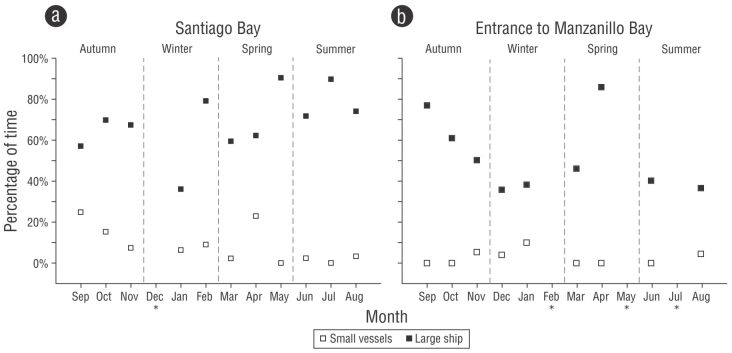
Figure 4 Percentage of time with shipping noise in Santiago Bay (a) and the entrance to Manzanillo Bay (b), across the year and by ship size. Large ships (filled) and small vessels (void). Note that small vessels were not detected (0%) for May and July in Santiago Bay and for September, October, March, April, and June at the entrance to Manzanillo Bay. Months without data available are marked with an asterisk.
Daily time with shipping noise
The hours of the day with higher percentage of shipping noise were in the afternoon (between 1200 and 1600 hours) (Fig. 5). This tendency was observed for most months, with clear peaks during the autumn and winter months.
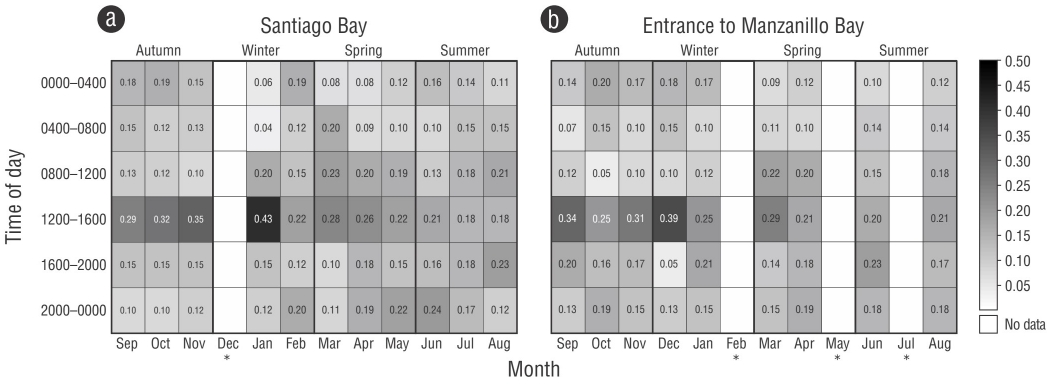
Figure 5 Heatmaps showing the percentage of shipping noise for both stations. Color-bar goes from 0.00 (0% lightest) to 0.50 (50% darkest) of the time in each slot. Each row represents a 4-h section of the day, and each column a month. The afternoon (1200 to 1600) was the time with higher percentage of shipping noise across the year, while autumn (September, October, and November) and winter (December, January, and February) were the seasons with relatively higher percentages. Months without data available are marked with an asterisk.
Sound pressure level
The median SPL values throughout the year were calculated considering large and small vessels combined. Median SPL was 164 dB re 1 μPa (range: 142-173 dB) for Santiago Bay and 157 dB re 1 μPa (range 142-168 dB) for the entrance to Manzanillo Bay, which indicates a sound pressure value more than twice (2.238) as high in Santiago Bay than at the entrance to Manzanillo Bay.
SPL value ranges throughout the year overlapped for most months in both locations (Fig. 6). However, the values found during autumn and winter were relatively higher than those in the other seasons. Moreover, for all situations, Santiago Bay showed higher SPL median values than the entrance to Manzanillo Bay. It is worth noting that during the winter months, humpback whale songs were detected along with shipping noise, indicating a possible important overlap (Fig. 7).
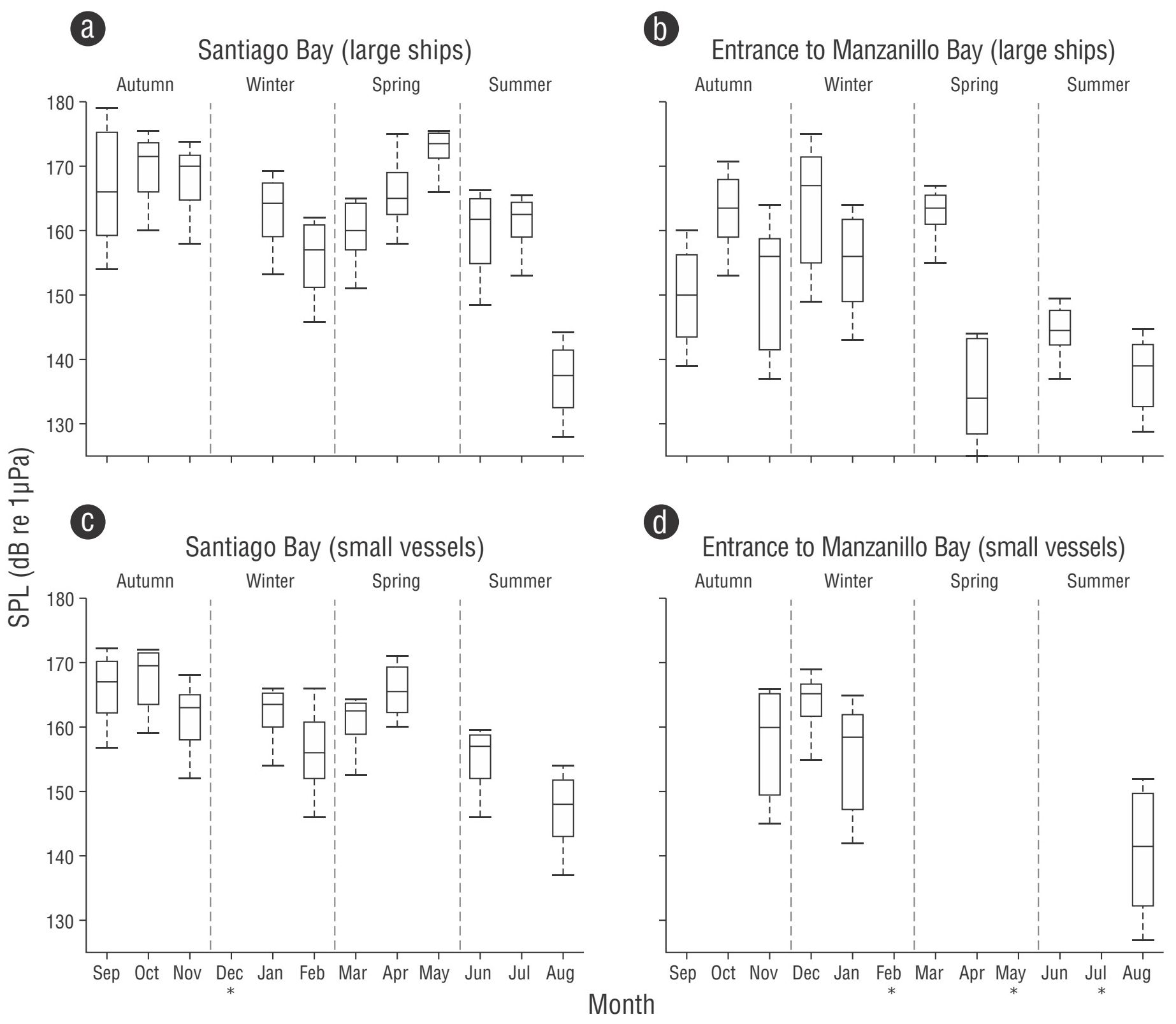
Figure 6 Sound pressure level (SPL) by month at each recording station. Median (central line) and quartiles (25th and 75th) are shown, with whiskers indicating maximum and minimum values for each month. Santiago Bay (a, c) and the entrance to Manzanillo Bay (b, d). Large ships at the top and small vessels at the bottom. Note that small vessels were not detected for May and July in Santiago Bay and for September, October, March, April, and June at the entrance to Manzanillo Bay; hence, SPL was not calculated. Months without data available are marked with an asterisk.
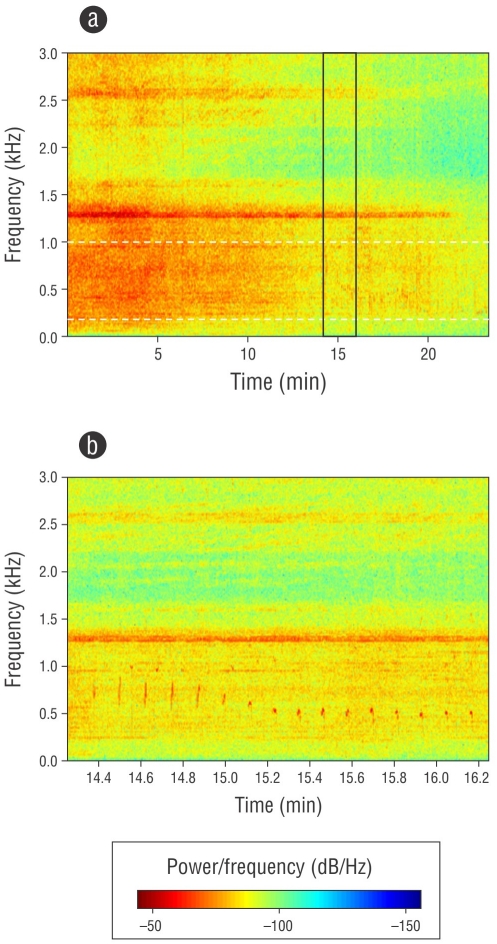
Figure 7 (a) Shipping noise (small vessel category) and humpback whale vocalizations (between the dotted white lines) as detected by the recording system in Santiago Bay. The noise contribution from the boat overlaps the frequency range for the humpback whale vocalizations (spectrogram: Hamming window size 8,192, 80% overlap). (b) Zoom of a section (black box) of humpback whale song with some boat noise in the background (spectrogram: Hamming window size 8,192, 80% overlap).
DISCUSSION
The Santiago-Manzanillo bay complex is an important international port and a popular resort area for national and international tourism (Silva-Iñiguez et al. 2007, Conde-Pérez et al. 2013, SCT 2014). It is also part of the northeastern Pacific, and it is relatively close to the Mesoamerican Biological Corridor, a multinational conservation area with a rich and diverse ecosystem that harbors invertebrates, fish, birds, and cetaceans (González-Sanson et al. 1997, Landa-Jaime et al. 1997, Arciniega-Flores et al. 1998, Miller et al. 2001, Holland 2012, Ortega-Ortiz et al. 2013). The constant flux of ships detected in the area is consistent with the activities happening at the Santiago Bay resort area and the Manzanillo commercial port at the entrance to the bay. In Santiago Bay, vessel noise was present 81.8% of the time, and this accounted for noise from small vessels associated with tourism activities and an outstanding contribution of noise from large vessels anchored or maneuvering in the area. The entrance to Manzanillo Bay, despite being the commercial port site, showed a lower proportion (48.6% of the time) of vessel noise than Santiago Bay, as there was lower contribution of small-vessel noise from tourism activities.
Anthropogenic noise has been acknowledged as an important stressor to cetaceans (Wright et al. 2007). The high percentage of time with constant shipping noise year-round found in this study could be affecting the fitness of dolphin resident species inhabiting the coastal area and the migratory baleen whale species that can be found in the whole bay complex during the winter-spring breeding season (Urbán and Aguayo 1987, Calambokidis et al. 2001). This is specially concerning for migratory species considering that the maximum percentages of time with shipping noise occurred in spring. The higher detection of overall shipping during late spring and summer in Santiago Bay (Fig. 3), compared to the entrance to Manzanillo Bay, might be related to the high tourism season (SECTUR 2014). The afternoon was the most active shipping period (Fig. 5), confirming leisure activities occurring in the afternoon. Daylight hours, on the other hand, are likely the most active for the port (González-Alatorre and Conde-Pérez 2011, SCT 2014).
High noise levels can be harmful to biodiversity in an area, from masking communication signals to causing physiological damage in adult and larval stages, depending on the source and exposure time (Richardson et al. 1995, Aguilar de Soto et al. 2013, Jain-Schlaepfer et al. 2018). Santiago Bay had a higher SPL median value (164 dB re 1 μPa) than the entrance of Manzanillo Bay (157 dB re 1 μPa). Small vessels are used for tourism activities and local fishing remain in the Santiago Bay vicinity, but large ships either go directly to the Manzanillo commercial port at the entrance or linger near Santiago Bay while waiting for access to the commercial port, contributing additionally to higher SPL values in Santiago Bay. The entrance to Manzanillo Bay showed a lower but constant SPL (130-140 dB re 1 μPa) throughout the year, as it is the main route to the commercial port and there are less small vessels in the area (Fig. 6). This situation can be problematic for the northeastern Pacific humpback whale subpopulation that arrives at the Mexican continental coast to mate and to give birth during the winter-spring months (Urbán and Aguayo 1987, Urbán et al. 2000, Calambokidis et al. 2001). Male humpback whales produce a complex song when competing with other males for access to females and when marking dominance or territoriality (Winn and Winn 1978, Payne et al. 1983, Payne and Payne 1985, Darling et al. 2006). In this study songs were detected during the sampling period (Fig. 7), with the frequency range overlapping with most of the shipping noise contribution to the ambient soundscape. Frequencies from coastal traffic and large ships travel far across the bay. Shipping noise disturbs male humpback whales singing (Norris 1995, Nowacek et al. 2007, Clark et al. 2009, Tsujii et al. 2018). Therefore, these songs might get disrupted considering that autumn and winter were found to be the seasons with the highest SPL values (Fig. 6), even when fewer ships were counted (Fig. 3).
The winter months showed the highest median SPL (160-170 dB re 1 μPa) in the Santiago Bay area, which could be associated with the peak holiday season for beach resorts in Mexico. It is important to consider this for coastal dolphin species, which are more likely to interact in Santiago Bay and could be surrounded by small tourist vessels reaching high frequencies that can potentially mask and disturb the animals during the tourist season. Unfortunately, the shortage of samples during the winter months might not reflect our assumption of Santiago Bay being an area of constant use (Fig. 4), but it can be reasonably inferred that boat presence would not necessarily decrease compared to the rest of the months and that noise activity at the entrance to Manzanillo Bay would continue in the winter.
Similar SPL values have been found in semi-enclosed bays in other countries considered to be important commercial areas, like Southold Bay in New York (Samuel et al. 2005, Simard et al. 2008) and Massachusetts Bay (Merchant et al. 2015), where the tendency to increase shipping capacity is a current issue. This trend is also occurring in the Santiago-Manzanillo bay complex, which contains the largest commercial port in Mexico. Therefore, ongoing monitoring could improve management of noise pollution caused by shipping in the area.
Final considerations
Large ships were detected at both Santiago Bay and the entrance to Manzanillo Bay, while small vessels were more commonly detected in Santiago Bay. Large ships were the most abundant, which was to be expected for the Manzanillo commercial port, as it is a port for international cargo entrance and delivery. Shipping noise is constant year-round at range levels considered high or similar to levels at other ports in the world (Samuel et al. 2005, Simard et al. 2008, Merchant et al. 2015). In addition, unmanaged and unorganized coastal development can increase anthropogenic noise in the ocean. This takes relevance when considering effective management of biodiversity in the area that can be affected by vessel noise. Therefore, with this bay complex being an important port for the country and a common corridor for migratory species, future studies should be carried out to evaluate the possible direct and indirect effects of shipping noise on local marine fauna in order to find the possible mitigation actions to protect natural resources and to continue to use this important international connection by sea. In addition, measurement of particle motion contribution, and not just sound pressure, would give a more complete picture of noise effects in the ocean and help achieve better mitigation systems, allowing for human development in a sustainable way and the establishment of appropriate regulations in benefit of the environment.











 texto en
texto en 




